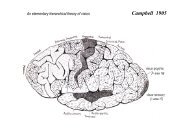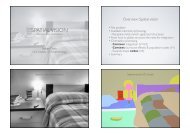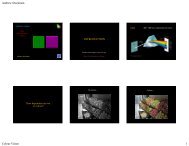Slow and fast pathways in the human rod visual system - CVRL main
Slow and fast pathways in the human rod visual system - CVRL main
Slow and fast pathways in the human rod visual system - CVRL main
Create successful ePaper yourself
Turn your PDF publications into a flip-book with our unique Google optimized e-Paper software.
1664 J. Opt. Soc. Am. A/Vol. 8, No. 10/October 1991<strong>rod</strong>s signals both to be evident <strong>in</strong> <strong>the</strong> b wave of <strong>the</strong> ERG,<strong>the</strong> two signals must be segregated at or before <strong>the</strong> bipolarcell level.Where <strong>the</strong>n does <strong>the</strong> cancellation take place? One attractivepossibility is that it occurs at <strong>the</strong> depolariz<strong>in</strong>g(ON) cone bipolars, one of <strong>the</strong> po<strong>in</strong>ts at which <strong>the</strong> twoanatomical <strong>pathways</strong> convey<strong>in</strong>g <strong>rod</strong> signals <strong>in</strong> <strong>the</strong> mammalianeye converge. At <strong>the</strong> scotopic levels at which <strong>the</strong>15-Hz null is found, <strong>the</strong> cone bipolars might be driven by<strong>the</strong> <strong>rod</strong> signals travel<strong>in</strong>g through <strong>the</strong> cone photoreceptors<strong>and</strong> <strong>the</strong> <strong>rod</strong> signals travel<strong>in</strong>g through <strong>the</strong> <strong>rod</strong> bipolars <strong>and</strong><strong>the</strong> AII amacr<strong>in</strong>e cells. The most obvious problem withthis model, however, is that <strong>the</strong> signal <strong>in</strong> <strong>the</strong> <strong>rod</strong> bipolarcell, although able to cancel <strong>the</strong> signal <strong>in</strong> <strong>the</strong> depolariz<strong>in</strong>gON cone bipolar, rema<strong>in</strong>s itself uncanceled. And, despiteits be<strong>in</strong>g uncanceled, <strong>the</strong>re is no trace of it <strong>in</strong> <strong>the</strong> b waveof <strong>the</strong> ERG, even though its (assumed) signal is clearly evidentbelow <strong>the</strong> null. Ano<strong>the</strong>r problem with this type ofmodel is that <strong>the</strong> <strong>rod</strong> signal enter<strong>in</strong>g <strong>the</strong> cones shouldappear <strong>in</strong> both ON- <strong>and</strong> OFF-cone bipolars, so that <strong>the</strong>signal <strong>in</strong> <strong>the</strong> OFF-cone bipolars rema<strong>in</strong>s uncanceled too.To some extent, we can contend with <strong>the</strong>se difficulties byargu<strong>in</strong>g that <strong>the</strong> null <strong>in</strong> <strong>the</strong> b wave is <strong>the</strong> result of <strong>the</strong>electrical cancellation of signals <strong>in</strong> <strong>the</strong> separate <strong>rod</strong> <strong>and</strong>cone bipolars, whereas <strong>the</strong> perceptual null is due to neuralcancellation at a later site, say, at <strong>the</strong> ganglion cell layer.But <strong>the</strong>n one must additionally assume that <strong>the</strong> electricalcancellation at <strong>the</strong> bipolar-cell level co<strong>in</strong>cides exactly with<strong>the</strong> physiological cancellation at <strong>the</strong> later stage.There is a fur<strong>the</strong>r objection, however, to <strong>the</strong> argumentthat <strong>the</strong> <strong>fast</strong>er <strong>rod</strong> signals travel over <strong>the</strong> cone gap-junctionpathway <strong>and</strong> that <strong>the</strong> locus of <strong>in</strong>teraction between <strong>the</strong>slower <strong>and</strong> <strong>fast</strong>er signals is <strong>the</strong> depolariz<strong>in</strong>g cone bipolars.It concerns <strong>the</strong> typical, complete achromat observer;namely, how does <strong>the</strong> <strong>fast</strong>er pathway orig<strong>in</strong>ate <strong>in</strong> <strong>the</strong> achromatobserver for whom <strong>the</strong>re is no psychophysical evidenceof postreceptoral cone vision <strong>and</strong> for whom <strong>the</strong>majority of <strong>the</strong> anatomical evidence 2 l- 2 4 suggests that conephotoreceptors are altoge<strong>the</strong>r miss<strong>in</strong>g or reduced to atmost 5-10% of <strong>the</strong>ir normal population (but see <strong>the</strong> discussionabove)?Thus attempt<strong>in</strong>g to correlate <strong>the</strong> psychophysically isolatedslow <strong>and</strong> <strong>fast</strong> <strong>pathways</strong> with <strong>the</strong> electrophysiologicallyrevealed <strong>rod</strong> bipolar <strong>and</strong> cone gap-junction <strong>pathways</strong>may turn out to be misdirected. 5 4 It seems possible that<strong>the</strong> <strong>in</strong>teraction lead<strong>in</strong>g to <strong>the</strong> cancellation is tak<strong>in</strong>g placeei<strong>the</strong>r at <strong>the</strong> <strong>rod</strong> bipolars <strong>the</strong>mselves or before <strong>the</strong> bipolarcell level, possibly with<strong>in</strong> <strong>the</strong> <strong>rod</strong> spherules, <strong>and</strong> that horizontalcells are implicated somehow. But wherever <strong>the</strong>site of cancellation, <strong>the</strong> prom<strong>in</strong>ence of <strong>the</strong> slow <strong>and</strong> <strong>the</strong><strong>fast</strong> signals <strong>in</strong> ERG record<strong>in</strong>gs does suggest that microelect<strong>rod</strong>erecord<strong>in</strong>gs should easily reveal <strong>the</strong> neuralsubstrate of <strong>the</strong> two signals.5. CONCLUSIONContrary to <strong>the</strong> traditional view that <strong>the</strong> <strong>human</strong> nighttime<strong>rod</strong> <strong>visual</strong> <strong>system</strong> is a relatively uncomplicated, unitaryprocess, we report electrophysiological <strong>and</strong> perceptual evidencefor a duality of organization. In addition to <strong>the</strong>familiar, slow <strong>rod</strong> signal, a <strong>fast</strong>er signal becomes prom<strong>in</strong>entat higher <strong>in</strong>tensities.ACKNOWLEDGMENTSWe thank Donald I. A. MacLeod <strong>and</strong> Ethan Montag forhelpful comments <strong>and</strong> Cornelia von Gruben for technicalassistance. We are especially grateful to Klaus RU<strong>the</strong>r forhis many contributions to <strong>the</strong> <strong>in</strong>vestigations. This researchwas supported by <strong>the</strong> National Science Foundation(BNS 88-12401), <strong>the</strong> Hoffmann-La Roche-Foundation, <strong>the</strong>Deutsche Forschungsgeme<strong>in</strong>schaft [SFB 325 (B4)], <strong>and</strong><strong>the</strong> Heisenberg Program.REFERENCESStockman et al.1. L. T. Sharpe, A. Stockman, <strong>and</strong> D. I. A. MacLeod, "Rodflicker perception: scotopic duality, phase lags <strong>and</strong> destructive<strong>in</strong>terference," Vision Res. 29, 1539-1559 (1989).2. W McDougall, "The sensations excited by a s<strong>in</strong>gle momentarystimulation of <strong>the</strong> eye," Br. J. Psychol. 1, 279-301(1904).3. F Ver<strong>in</strong>ga <strong>and</strong> J. Roeloffs, "Electro-optical stimulation <strong>in</strong> <strong>the</strong><strong>human</strong> ret<strong>in</strong>a," Nature (London) 211, 321-322 (1966).4. D. I. A. MacLeod, "Rods cancel cones <strong>in</strong> flicker," Nature(London) 235, 173-174 (1972).5. T. E. Frumkes, M. D. Sekuler, M. C. Barris, E. H. Reiss, <strong>and</strong>L. M. Chalupa, "Rod-cone <strong>in</strong>teraction <strong>in</strong> <strong>human</strong> scotopicvision-I. Temporal analysis," Vision Res. 13, 1269-1282(1973).6. T. J. T. P. Van den Berg <strong>and</strong> H. J. Spekreijse, "Interactionbetween <strong>rod</strong> <strong>and</strong> cone signals studied with temporal s<strong>in</strong>ewave stimulation," J. Opt. Soc. Am. 67, 1210-1217 (1977).7. S. Hecht, S. Shlaer, E. L. Smith, C. Haig, <strong>and</strong> J. C. Pesk<strong>in</strong>,"The <strong>visual</strong> functions of <strong>the</strong> complete colorbl<strong>in</strong>d," J. Gen.Physiol. 31, 459-472 (1948).8. J. D. Conner <strong>and</strong> D. I. A. MacLeod, "Rod photoreceptors detectrapid flicker," Science 195, 689-699 (1977).9. J. D. Conner, "The temporal properties of <strong>rod</strong> vision,"J. Physiol. (London) 332, 139-155 (1982).10. R. F. Hess <strong>and</strong> K. Nordby, "Spatial <strong>and</strong> temporal limitsof vision <strong>in</strong> <strong>the</strong> achromat," J. Physiol. (London) 371, 365-385(1986).11. L. T. Sharpe <strong>and</strong> K. Nordby, "Total colour bl<strong>in</strong>dness: an <strong>in</strong>t<strong>rod</strong>uction,"<strong>in</strong> Night Vision: Basic, Cl<strong>in</strong>ical <strong>and</strong> AppliedAspects, R. F. Hess, L. T. Sharpe, <strong>and</strong> K. Nordby, eds. (CambridgeU. Press, Cambridge, 1990), pp. 253-289.12. L. T. Sharpe <strong>and</strong> K. Nordby, "The photoreceptors <strong>in</strong> <strong>the</strong>achromat," <strong>in</strong> Night Vision: Basic, Cl<strong>in</strong>ical <strong>and</strong> AppliedAspects, R. F Hess, L. T. Sharpe, <strong>and</strong> K. Nordby, eds. (CambridgeU. Press, Cambridge, 1990), pp. 335-389.13. K. Nordby <strong>and</strong> L. T. Sharpe, "The directional sensitivityof <strong>the</strong> photoreceptors <strong>in</strong> <strong>the</strong> <strong>human</strong> achromat," J. Physiol.(London) 399, 267-281 (1987).14. L. T. Sharpe <strong>and</strong> V. Volbrecht, "Estimat<strong>in</strong>g middle- <strong>and</strong> longwavecone sensitivity with large, long <strong>and</strong> t<strong>in</strong>y, brief targets,"Perception (to be published).15. M. Aguilar <strong>and</strong> W S. Stiles, "Saturation of <strong>the</strong> <strong>rod</strong> mechanismof <strong>the</strong> ret<strong>in</strong>a at high levels of stimulation," Opt. Acta 1,59-65 (1954).16. M. F Marmor, G. B. Arden, S. E. G. Nilsson, <strong>and</strong> E. Zrenner,"St<strong>and</strong>ard for cl<strong>in</strong>ical electroret<strong>in</strong>ography," Arch. Ophthalmol.107, 816-819 (1989).17. G. Wyszecki <strong>and</strong> W S. Stiles, Color Science: Concepts <strong>and</strong>Methods, Quantitative Data <strong>and</strong> Formulae, 2nd ed. (Wiley,New York, 1982).18. W S. Stiles <strong>and</strong> B. H. Crawford, "The lum<strong>in</strong>ous efficiencyof monochromatic rays enter<strong>in</strong>g <strong>the</strong> eye pupil at differentpo<strong>in</strong>ts," Proc. R. Soc. London Ser. B 112, 428-450 (1933).19. W S. Stiles, "The directional sensitivity of <strong>the</strong> ret<strong>in</strong>a <strong>and</strong> <strong>the</strong>spectral sensitivities of <strong>the</strong> <strong>rod</strong>s <strong>and</strong> cones," Proc. R. Soc.London Ser. B 127, 64-105 (1939).20. L. T. Sharpe, H. Collewijn, <strong>and</strong> K. Nordby, "Fixation, pursuit<strong>and</strong> nystagmus <strong>in</strong> a complete achromat," Cl<strong>in</strong>. Vision Sci. 1,39-49 (1986).










